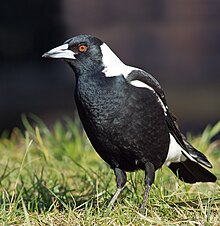Australian magpie
The Australian magpie (Gymnorhina tibicen) is a large black-and-white bird. It lives in most parts of Australia and in a small part of New Guinea. It is not closely related to the European magpie: they just look rather similar.
| Australian magpie | |
|---|---|

| |
| G. tibicen hypoleuca, Tasmania | |
| Scientific classification | |
| Domain: | Eukaryota |
| Kingdom: | Animalia |
| Phylum: | Chordata |
| Class: | Aves |
| Order: | Passeriformes |
| Family: | Artamidae |
| Genus: | Gymnorhina Gray, GR, 1840 |
| Species: | G. tibicen
|
| Binomial name | |
| Gymnorhina tibicen (Latham, 1801)
| |

| |
| Australian magpie ranges of subspecies | |
| Synonyms | |
|
Cracticus tibicen | |
Australian magpies are related to butcherbirds and currawongs. They are in the family Artamidae.[2]
The Australian magpie is in its own genus Gymnorhina and is related to the black butcherbird (Melloria quoyi). They live in bush land and in cities near people.
Description
changeAustralian magpies are from 37 to 43 cm long. They do not have very long tails like European magpies. An adult magpie has red eyes, black legs, and a white beak with black tip.
There are nine kinds of magpies (subspecies or races) in different parts of the country. Some subspecies have black backs and some have white.
Behaviour
changeThey walk on the ground where they look for insects and lizards to eat. Many other birds hop (move with small jumps), but magpies walk. When they are not looking for food, they stand or perch by holding on with their feet while they stand or crouch in trees or on man-made structures.
When magpies have baby chicks in their nests, the adults will “swoop” at nearby people – flying at their heads – to chase them away.
Some people feed magpies by throwing small pieces of meat to them. Magpies can learn to come near humans for food. They do not usually let people touch them.
References
change- ↑ BirdLife International (2012). "Gymnorhina tibicen". IUCN Red List of Threatened Species. 2012. Retrieved 26 November 2013.
- ↑ Christidis L. & Boles W.E. 2008. Systematics and taxonomy of Australian birds. Canberra: CSIRO Publishing. p. 196. ISBN 978-0-643-06511-6
